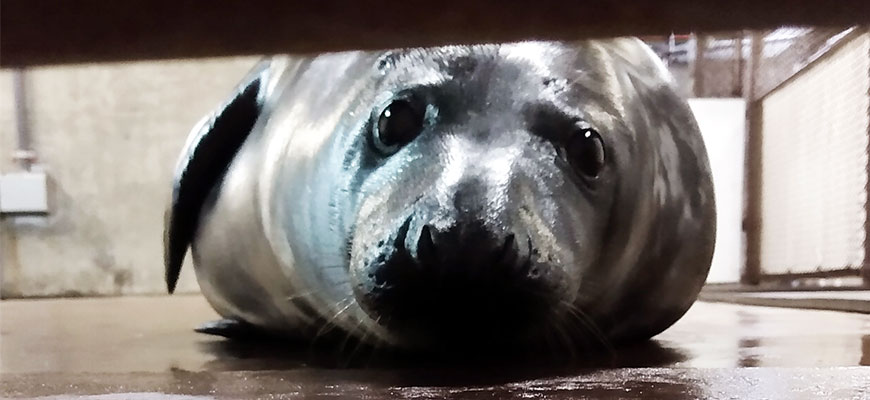Both Sponsored by T-Mobile
CONTACT: Kyle Shepherd
502-238-5331 (Media Cell 502-744-5639)
kyle.shepherd@louisvilleky.gov
LOUISVILLE, Ky. (January 26, 2021)
Gray Seal Cam
Guests can now check in on their favorite new gray seal pup with today’s launching of the Zoo’s new gray seal live webcam at Glacier Run sponsored by T-Mobile. The cam is accessible here: LouisvilleZoo.org/sealcam.
The pup has been weaned and is now perfecting his swimming skills in his private pool area. He will soon be learning to train with keepers at Glacier Run.
“Being able to virtually follow the pup, and watching the process as the pup graduates to the exhibit pool with our other seals should be a fun and educational experience for our guests,” said Louisville Zoo Director John Walczak. “Moreover, being able to provide this webcam is the perfect way to help further our mission, which is to better the bond between people and our planet.”
Help the Zoo Name the Pup
In addition to watching his adventures on the seal cam, fans of the Zoo will be able to help the Zoo name the new gray seal pup. Three names have been chosen by Glacier Run keepers. Guests can vote for their favorite name through 11:59 p.m. on February 23 at LouisvilleZoo.org/vote for a minimum requested donation of $5. Guests can also vote for their favorite name by dropping dollars and coinage in the naming kiosk on the Zoo’s plaza. The money raised will go toward the care and feeding of the pup. A winning name will be announced live on the Zoo’s Facebook page on February 25 at 10 a.m.
Guests can also follow the pup’s journey by watching the Zoo’s Saturday Seal “Pup-dates” sponsored by T-Mobile on the Zoo’s website and social media channels. T-Mobile is offering guests a chance to register at https://www.tmoevents.com/participants/public/register/23511 to have a chance to win a behind-the-scenes tour with the seal pup and a T-Mobile swag bag.
The three names the public can vote on are:
Finsbay (Fins-bee)
Glacier Run keeper Tracy Unger put forth this name and based her recommendation on the fact that the natural habitat for gray seals includes the coasts of the Northern Atlantic Ocean including Scotland. Off the western coast of Scotland is a group of islands called the Outer Hebrides and Finsbay is a town in that group of islands. Finsbay is known for its trout, arctic char, sea trout, and salmon fishing which makes it a logical stopping point for harbor and gray seals. The seals can be seen basking there any time of the year and return to land to molt near Finsbay in February through April. Finsbay is located south of the island of Rona, which is the origin of our seal Rona’s name.
Oban (Oh-bn)
Glacier Run keeper Anna Stradley put forth this name and based her recommendation on the Scottish Sea Life Center in Oban, Scotland, which became involved in seal conservation and rescue in 1980 when they took in a harbor seal pup that was abandoned by her mother. In more recent years, they have rescued on average 12 – 15 pups a year, releasing them back to the ocean once their rehabilitation and rearing was complete. Unfortunately, the center had to close due to financial issues in 2018, but they rescued and released 41 gray seals while in operation.
Noaa (No-uh)
Glacier Run keeper Drew Koch put forth this name and based his recommendation on the National Oceanic and Atmospheric Administration (NOAA), an agency that works to keep the public informed of the changing environment. NOAA’s roots date back to the 1800s and is America’s first conservation agency. Today, NOAA Fisheries are responsible for the nation’s ocean resources and their habitats. The western population of gray seals is found off the northeast coast of North America from New England into Canada.
The seal pregnancy was a planned part of the Association of Zoos and Aquariums (AZA) Species Survival Plan (SSP) for gray seals. Breeding plans work to maintain the genetic diversity of managed animal populations.
The Louisville Zoo has a history with this species. Eight seal pups have been born at the Zoo; when twin seal pups were born in 1979, they were the first twins to be documented in a managed system like a Zoo.
About Gray Seals
Gray seals are found in temperate and subarctic coastal waters of the North Atlantic. This species can be distinguished from harbor seals by their long noses, wider set nostrils, and size, which is approximately twice as large as harbor seals. Gray seals primarily eat fish. At the Zoo, squid is a treat. Seals have good senses to help them hunt. Their underwater eyesight and hearing are excellent. They can use their long whiskers, or vibrissae, to touch objects or perceive and analyze water movements. Gray seals can sleep underwater for up to 30 minutes at a time.
About the Louisville Zoo
The Louisville Zoo, a nonprofit organization and state zoo of Kentucky, is dedicated to bettering the bond between people and our planet by providing excellent care for animals, a great experience for visitors, and leadership in scientific research and conservation education. The Zoo is accredited by the Association of Zoos and Aquariums (AZA).
# # #

